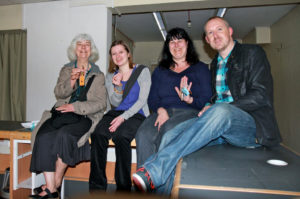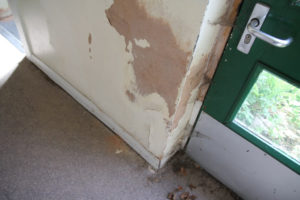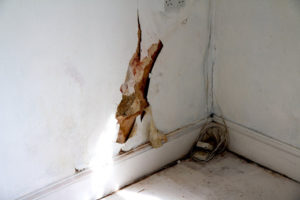3. Setting Up The Mill
Part of People Making Things Happen, a Big Lottery funded project exploring the history of The Mill.
After lying empty for several years and with various possibilities being put forward for its future, eventually the council agreed that the building could be rented by a community group if the funds were raised. A group of residents, including the Save the Library campaigners, made an application for £150,000 to Nesta via the Blackhorse Action Group (BAG). The application was successful and the group were able to take over the building, setting up as a charity and bringing together a board of trustees, and opening to the public in September 2011.
Initial plans had been to rent the downstairs only while other groups would separately rent rooms upstairs; it became clear this wouldn’t be possible and so instead the group rented the entire building and aimed to bring in additional funding from room hires, the upstairs rooms being leased on a long term basis to community organisations, artists and small businesses.
Oral History extracts
Scroll down for transcripts
Film by Neil Meads about The Mill’s first year (2012)
Oral History Transcripts
1. Alison Griffin
They said they really wanted to hear from grass-roots communities so we didn’t have to have three years of registered charity accounts or anything. I took a look at it and actually couldn’t see why not, I was quite relieved, having said “Of course we’ll fundraise!” So I thought my job was to say a, to the council “I’m on to something, hold off…” and if I could get us onto that shortlist through my bid-writing skills, we’d bought time, we’d got rid of that deadline. And that, to my surprise, is what we did.
2. Neil Meads
We just carried on with our meetings in, mostly in Alison’s front room, BAG people, a few St. James Library people and then you know BAG had had meetings where other people like Ingrid had got involved after the bid had been won, who became key parts of the project, and it was just… ‘what we do next?’ You know, none of us have expertise in this area. We’ve got to find someone to rent rooms upstairs, we’ve got to find a way of renovating the place. We were just a bit out of our depth, if I’m honest, we were trying to recruit people to start and it was just terrifying, that would be my characterisation of it.
3. Clare Coghill
We would sit in Alison Griffin’s living room. And I would make coffee or pour wine or just chat and take notes, because I thought that was the way in which I could be helpful. But then I would also be in the room when, you know, this stumbling block, that we need to get the council to agree to this, that was also clear. And I was involved in lots of those discussions. And we had a really brilliant discussion with somebody from one of the funding organisations who supported that first cash from Nesta. And I can remember her turning to me and saying, ‘Well, it really does require, you know, you’ve got all these amazing people here, you’ve got this amazing idea. You’ve got the fund. But if you can’t get the council to get to do you a lease, then we’re all going home.’ And what a waste that would be. So I did feel the responsibility of that. I hesitate to say pressure because it didn’t feel like pressure because I knew that we could do it. And I knew that those people around that table had the commitment and the drive to get it done.
4. Mo Gallaccio
Eventually, we got the key to the building and we opened it up, and it was in a pretty terrible state. Anyway, one Saturday, we opened the doors and said to people, “This is your building” and people came in and they said, “Oh, this is absolutely terrific! What a lovely space. What are you going to do?” And we went, “No, no, no, what are you going to do?”
5. Ruth Duncan
I really liked the fact that we’d done it, and, you know, all the work that Alison and Ingrid and Mo put in, you know, you know, we had this functioning building that was, you know, turned into somewhere- you know, and so, there was so much creativity, and ingenuity had gone into doing, you know, creating, or creating this building on…. you know, 150 grand was a lot, but it didn’t go, you know, when you’ve got a building to renovate, because the building was crumbling, and you’ve got three staff to hire and lots of this other stuff, you realise, oh, gosh, this, this money doesn’t go that far. And, and, yes, so that, so what was done in terms of creating the building, and then what we were thinking about putting in it, you know, lots of Mo’s art themes, and, you know, there were there was, and the way that, the way that people would come forward and say, I can do this, or I can do that. And you’d go “Yeah, do it, go, go on.” And you know that it attracted people. And people would kind of stop in and go, “Oh, gosh, this is really good.” So it just felt really good to have done something for my local area, you know, be part of that, and that then attracted more people to come in and maybe do something for themselves, or that made, you know, made their day a bit better, or, you know, that that that was it really, just think, yeah, we did a really good thing there.
6. Ingrid Abreu Scherer
It was really dark, it was damp, it was very much shaped like the library so it still had the check-out desks and the foyer, the other rooms had been occupied by people so there was a shower in what is now the disabled toilet, the other rooms had just lots of mess in them and people had obviously tried to make them homey but it’s very difficult if you’re in a commercial building, so it looked like an abandoned library, basically. The metal frames for the heating systems were still there, the heating was not working, and the metal frames for the big computer stacks were still at the desks. We actually used them, they’re still downstairs, they’re the legs of the benches, so we kind of quite quickly went on a bit of a scavenger hunt to work out what we could keep and what we needed to get rid of. The strip of garden at the back was completely overgrown, you could feel glass crunching underneath, it was just a bit of a tip really. Obviously all the windows at the front were boarded up, to me that’s the biggest change we made very quickly, is we took down the boards from the window and we let people see what was inside, and I think that was quite a conscious decision from us right from the beginning, to say “This needs to be a transparent building for people, people need to be able to see inside and see what’s going on in here because they need to be able to see how they can get involved.” And also because it’s a tip and it’s going to take us ages to clean up and as soon as we got the keys people were saying “Oh, when are you going to open? When are you going to open?” So we needed to show people this is the job. So we did that really early, that’s one of the first things we did.
7. Clare Coghill
There’s a little story that I just have to tell, which is that getting that money from Nesta was incredible. And Alison did the work along with the other community volunteers to make that a reality. And to get that money, and that was, that was huge. That was absolutely huge. But when, I remember when they went to the sort of, there was a shortlist of 50. And then those organisations all had to go to the, to the sort of away day thing. And they were asked to put themselves in size order. And there were organisations from, you know, massive city councils. And the smallest of all the organisations was the Mill. And the fact that the Mill got through that process, I think there were only 17 that were funded in the end, just spoke to how extraordinary the idea was, how extraordinary the people involved were, and are, and the audacity at the time of taking an empty building and turning it over to the community. Because it’s become something that’s quite, that’s, that’s recognised now as something that’s a possibility. And something that councils will consider, but then it wasn’t, it was considered very high risk, and lots of paternalistic politicians up and down, the country didn’t want to give these opportunities and would rather just sell the buildings or knock them down or leave them to rot. And actually, ideally, the library would have stayed open. Ideally, there would be public sector workers staffing it. But when you’ve had hundreds of millions of pounds, taken out your budget, that’s not the reality. So at the at least, these buildings stay open. And at best, they are run and led by extraordinary people and used by extraordinary people.





 Follow
Follow